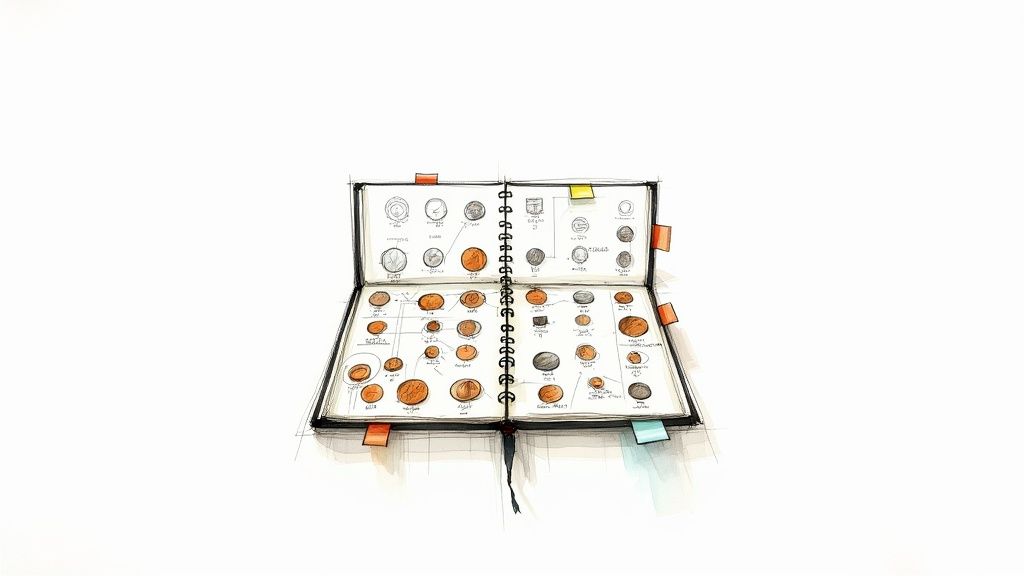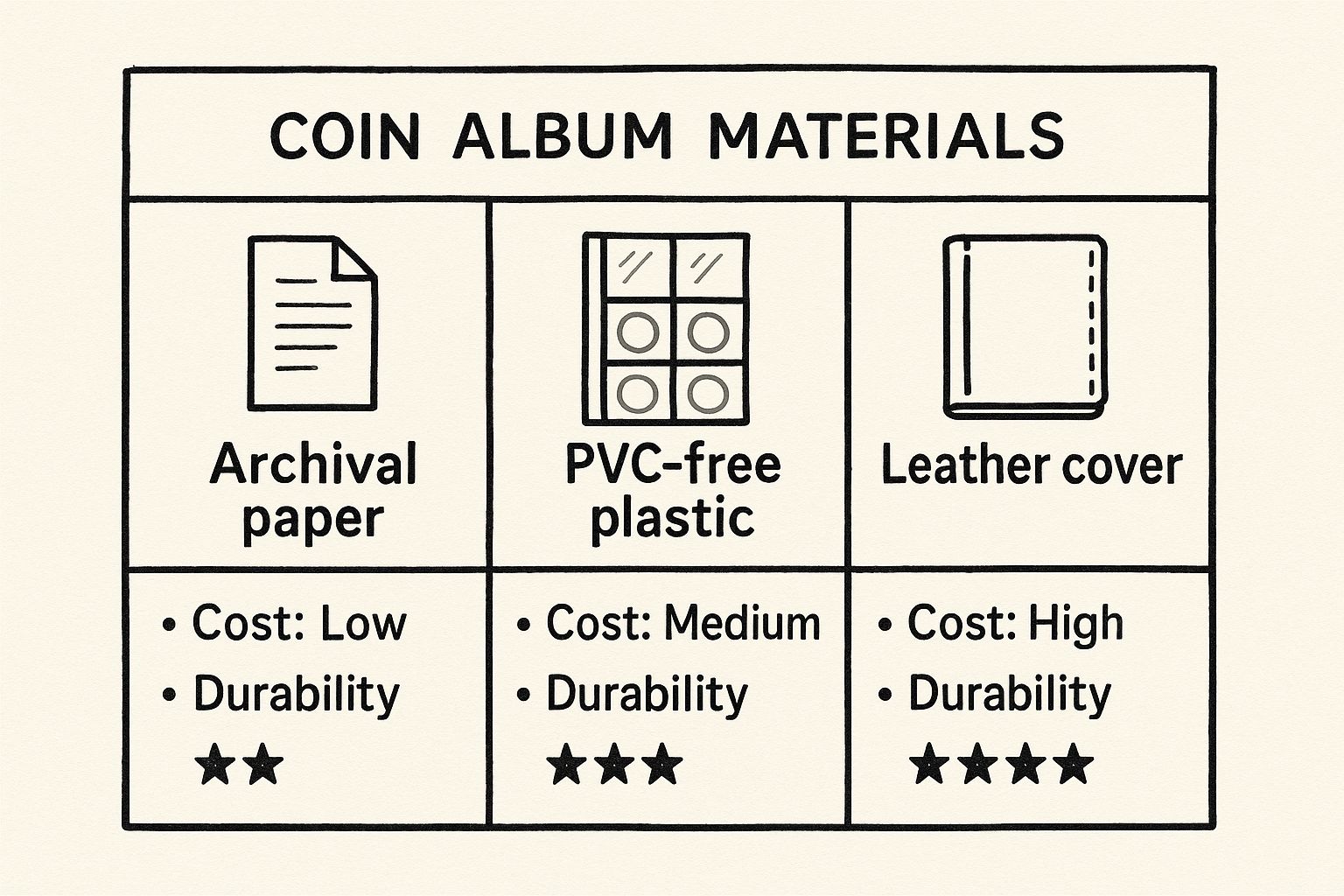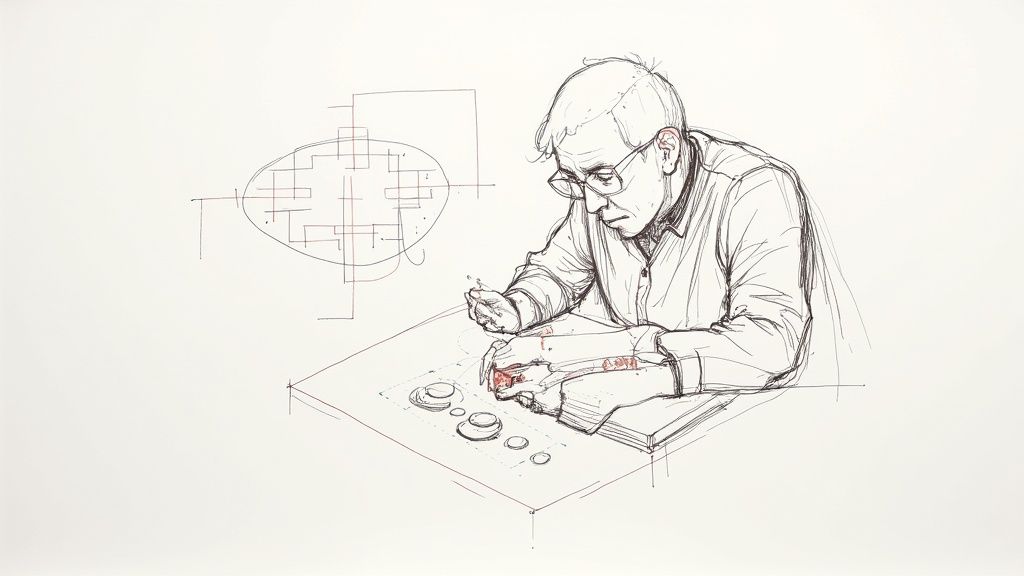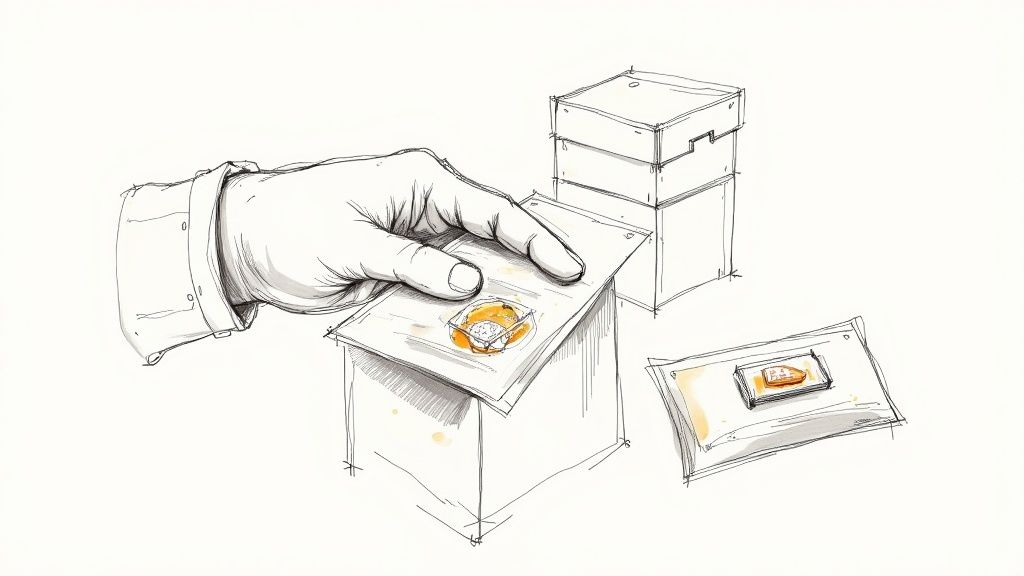When it comes to your collection, picking the right album for coin collection is easily the single most important purchase you’ll ever make. Think of it as the primary line of defence for your coins. It’s far more than just storage; a quality album is what preserves a coin's condition and, in turn, its long-term value.
Why a Quality Coin Album Is Non-Negotiable

Before we get into the different styles and materials, let's be clear on why a proper album isn't just a "nice to have"—it's a foundational piece of kit for any serious collector. It might be tempting to just use a simple cardboard box or a generic plastic folder, but you’d be taking a massive risk with your collection. The wrong environment can, and often does, cause irreversible harm.
A dedicated album does a lot more than just keep things organised. It's your collection's first and best defence against the common threats that can strip a coin of its value and appeal.
Protecting Against Physical and Environmental Damage
Every single time you handle a coin with your bare hands, you risk leaving behind fingerprints. The oils from your skin can cause corrosion over time, permanently marring the surface. A good album provides a secure home for each coin, minimising the need for direct contact. It also shields your coins from those accidental scratches, dust, and all sorts of airborne contaminants.
Just picture a rare commemorative 50p coin. If you store it improperly—say, in a damp room—it could be exposed to humidity. Before you know it, toning or even spotting can start to appear. This process, known as oxidation, can permanently change the coin's surface.
An archival-quality album, one that's free from harmful acids and chemicals, creates a stable micro-environment. It ensures the mint lustre on that 50p stays as brilliant as the day it was struck, preserving its condition and numismatic worth for years to come.
Building a Legacy, Not Just a Hoard
Ultimately, a well-chosen album is what transforms a random assortment of coins into a curated historical timeline. It brings a sense of order and narrative to your collection, allowing you to properly appreciate the artistry and history packed into each piece. This organised approach is incredibly satisfying and turns a simple hobby into a lasting legacy.
The key benefits really speak for themselves:
- Value Preservation: Keeping a coin in its original condition is the number one factor in its long-term financial value.
- Enhanced Organisation: You can easily view, sort, and display your collection, making it much simpler to spot gaps or follow certain themes.
- Damage Prevention: It protects against fingerprints, scratches, humidity, and the harmful chemicals often found in cheap plastics.
Choosing the right album for coin collection is a direct investment in the future of your hobby. It's the best way to make sure that all the time and money you've put into finding your coins is properly protected.
Navigating the Different Types of Coin Albums
Picking the right album for coin collection can feel like a minefield, but it really just comes down to matching the album's style to what you collect and how you want to protect it. Not all albums are created equal, and believe me, the wrong choice can cause real headaches—and even damage—down the line.
Let's break down the most common options you'll come across as a UK collector.
The simplest starting point is often the humble coin folder. These are essentially pre-printed cardboard albums with slots for specific sets. Think of the hugely popular Beatrix Potter 50p coins or the Great British Coin Hunt A-Z 10ps. They’re absolutely brilliant for beginners or for anyone wanting to organise the interesting coins they find in their change.
While folders are fantastic for getting started, they offer minimal protection. The coins are usually exposed on one side, leaving them vulnerable to fingerprints, dust, and airborne contaminants. This makes them a poor choice for valuable or uncirculated coins that demand much better preservation.
Versatile Binders and Premium Albums
For more flexibility, many collectors I know swear by ring binders. These systems use individual pocketed pages, which means you can mix and match layouts to suit coins of all shapes and sizes. You can build a completely custom collection, housing hefty £5 crowns next to tiny pre-decimal silver threepences, all in one place.
This modular approach is perfect if you’re building a thematic collection that just won’t fit into a pre-made folder. But here’s the crucial bit: you must ensure the binder and the pages are made from archival-quality, PVC-free materials. This is non-negotiable. PVC can react with the metal over time, causing irreversible ‘green gunk’ and ruining your coins.
At the top end of the market, you’ll find screw-post albums. These offer a premium, library-bound look and feel, built for the serious numismatist. The pages are held securely by screw-in posts, giving the album a sturdy, permanent quality that’s ideal for housing valuable proof sets or professionally graded coins.
To help you decide, I’ve put together a quick comparison of the most common album styles available to UK collectors.
Coin Album Styles Compared for UK Collectors
This table breaks down the main types of albums, outlining their pros, cons, and what they're best suited for.
| Album Type | Best For | Pros | Cons | Material Focus |
|---|---|---|---|---|
| Folders | Beginners, circulating coin sets (e.g., 50p hunts) | Inexpensive, easy to find, pre-labelled for specific series | Minimal protection, coins are exposed, not archival quality | Cardboard, thin plastic film |
| Ring Binders | Custom collections, various coin sizes, thematic displays | Highly flexible, easy to add/reorganise pages, good protection | Quality varies, requires buying PVC-free pages separately | Plastic (ensure PVC-free), faux leather, or vinyl covers |
| Screw-Post Albums | High-value collections, proof sets, graded coins | Excellent protection, premium look and feel, very durable | More expensive, less flexible for reorganisation | High-quality archival board, leather/leatherette, inert plastics |
Ultimately, the right album is a personal choice that balances protection with presentation.

As you can see, while premium materials like real leather covers certainly add to the cost, the essential archival-quality plastics and papers that do the real work of protecting your coins are very affordable. Your choice really depends on balancing your budget with your collection’s specific needs and how you want it to look on your shelf.
Matching an Album to Your Collection's Focus

Every collection tells a story, and the album for coin collection you choose should be the book that tells it. A generic, off-the-shelf folder just won't cut it when your interests get specific. For example, if your passion is for coins from Queen Elizabeth II’s reign, or perhaps you're building a set of the new King Charles III portraits, you need an album that brings that specific narrative to life.
The first big decision is the format. If you're chasing a popular and finite set, like the complete Beatrix Potter 50ps or the London 2012 Olympics series, a pre-printed folder with labelled slots is ideal. It gives you a clear structure and a satisfying sense of completion as you fill the gaps.
But what if your collection is more... eclectic? Maybe you have a few Roman denarii sitting alongside modern commemorative crowns. In that case, a customisable binder system is a much better fit. It gives you the freedom to create your own layout and tell your own unique collecting story, page by page.
Aligning Album Type with Collection Style
The physical size and shape of your coins are just as important as their theme. You simply can't treat every coin the same. A chunky £5 crown, for instance, needs a much deeper and more secure pocket than a slender, pre-decimal silver threepence. Trying to squeeze a big coin into a standard slot is a surefire way to damage both the coin and the album page.
This is where binder systems with interchangeable pages really come into their own. You can mix and match pages with different pocket sizes, creating a perfectly tailored home for every single piece in your collection.
The aim is to find an album that doesn't just store your coins, but actually enhances the collection itself. The album should feel like an integral part of your collection, not just a box you put it in.
Considering Modern Collecting Trends
The UK coin market is always moving, with new releases constantly shifting what people are looking for. This definitely influences your choice of album. Collecting circulating £1 coins, for example, has become a massive area of focus, with mintage numbers driving rarity.
Take the 2022 £1 coin. It's now the rarest in circulation, with The Royal Mint striking only 7.735 million. This coin marks the final £1 design to feature Queen Elizabeth II before the 2023 switch to King Charles III, making a dedicated space in an album essential for any serious modern collector. If you want to know more, it's worth checking out which £1 coins are worth collecting in 2025.
Ultimately, picking an album for your coin collection means thinking about what you have now and what you might collect in the future. A flexible system lets your storage grow and adapt right alongside your passion.
Protecting Your High-Value and Special Edition Coins

Sooner or later, you'll come across a coin that’s a cut above the rest. Maybe it’s a limited mintage commemorative or a flawless uncirculated set. For these crown jewels of your collection, just slipping them into a standard album pocket doesn't quite feel right. It isn’t enough.
For these special pieces, you need to think in terms of layered defence. This means giving each coin its own individual protection before it ever touches the page of your album. Think of it like this: your album is the carry bag for your phone, but the individual case you snap it into is what really protects it from bumps and scratches.
Creating a Multi-Layered Defence
When it comes to high-value coins, this first layer of defence is non-negotiable. It provides a crucial buffer against fingerprints, knocks, and environmental nasties, ensuring your investment pieces stay in pristine condition.
There are a few excellent options, each with its own merits:
- Individual Capsules: These are the gold standard for many collectors. They're hard, transparent plastic shells that click securely around a single coin. A capsule offers fantastic protection from scratches, air, and clumsy fingers. Putting a rare Isle of Man TT £2 coin in one of these before it goes into an album is simply smart collecting.
- 2x2 Cardboard Flips: A true collector's staple. These are simple cardboard squares with a Mylar window. You pop the coin in the centre, fold it over, and staple it shut. They’re cheap, effective, and you can write key details right on the cardboard surround.
- Certified Slabs: For the absolute top-tier coins in your collection, getting them professionally graded is a wise move. The coin is returned to you permanently sealed in a tamper-proof plastic holder, or "slab," which displays its grade and guarantees its authenticity.
The core idea here is simple: minimise direct contact and exposure to the elements. By encasing a special coin individually, you preserve its surface and lustre far better than an album page ever could on its own.
This strategy is especially important for modern collectibles. Special editions are a huge part of the UK collecting scene, and any decent album for coin collection should be able to accommodate these bulkier, protected coins.
For example, the 2025 Isle of Man TT £2 coin is expected to have a tiny mintage of just 5,000 for circulation, making it a prime candidate for extra protection from day one. You can keep an eye on mintage figures and key releases through numismatic experts like ChangeChecker.org.
Ultimately, safeguarding these coins isn't just about neat storage; it's about protecting their long-term value. To learn more about the financial side of things, our guide on coin collection insurance provides essential information.
Smart Strategies for Long-Term Care and Organisation
Finding the perfect album is a brilliant first step, but keeping your collection in top condition is an ongoing mission. Getting into good habits from the start will safeguard the condition and value of your coins for years, turning a simple hobby into a legacy you can be proud of.
The absolute first rule of thumb is proper handling. Always pick up your coins by their edges. The natural oils on your fingers can cause permanent damage and corrosion on a coin's surface, which is heartbreaking to see. For any coins of real value, it’s well worth investing in a simple pair of soft cotton gloves to remove the risk altogether.
Beyond just how you touch them, where you store them is crucial. Coins are happiest in a stable, cool, and dry environment, well away from direct sunlight. Big swings in temperature and humidity are the enemy of any metal, leading to ugly toning or spotting over time. We go into much more detail on the ideal conditions in our complete overview of proper coin collecting storage.
Cataloguing Your Collection
A well-organised collection isn't just immensely satisfying to look at; it's also your single best tool for tracking its growth. Cataloguing is simply the process of recording the key details of each coin you own. It's essential for insurance and, just as importantly, for understanding the story your collection tells.
You don't need any fancy software to get going. In fact, sometimes the simplest methods work best:
- A Handwritten Ledger: There's a classic, tactile satisfaction to using a dedicated notebook.
- A Digital Spreadsheet: Makes it incredibly easy to sort your collection and track what you paid versus current values.
- Dedicated Apps: Plenty of great numismatic apps are out there to help you catalogue everything straight from your phone.
Whichever path you choose, just be consistent. Make sure you're noting down details like the coin's country of origin, year, denomination, its condition, and any mintage figures you can find.
Keeping a detailed inventory is absolutely crucial in a growing market. It lets you track not just what you own, but also its potential value as trends shift and certain pieces become more sought-after.
The UK coin collecting market has seen some really solid growth, with the global market valued at a staggering USD 18.10 billion in 2023. You only need to look at historic pieces like the 2009 Kew Gardens 50p—with only 210,000 ever minted—to see why records are vital. These regularly sell for over £150. You can get more great insights about collectable coins in the UK on vintage-collectables.co.uk.
Your Coin Collection Album Questions Answered
Even when you think you’ve got everything sorted, a few questions always seem to pop up when you're choosing or using a new album for your coin collection. Let's run through some of the most common queries we hear from fellow collectors, giving you clear, straightforward answers to help you look after your coins.
What Does PVC-Free Mean and Why Is It Important?
You’ll see the term ‘PVC-free’ everywhere, and for a good reason. PVC, or polyvinyl chloride, is a common plastic that contains chemical softeners to make it flexible. The trouble is, over time, these chemicals can 'leach' out and coat your coins in a sticky, green film. In the numismatic world, we call this "PVC damage."
This green gunk isn't just unsightly; it's corrosive and can permanently etch the surface of a coin, completely tanking its value.
When an album is labelled 'PVC-free', it means it uses inert, stable plastics like polyester or polyethylene. These are archival-quality materials that won’t break down or release harmful chemicals. This is easily the most critical feature to look for if you're serious about long-term storage.
Should I Clean My Coins Before Putting Them in an Album?
The short answer, in almost every single case, is a hard no.
Trying to clean a coin, especially with harsh chemicals or abrasive cloths, strips away its original surface and natural patina. This process leaves behind a network of microscopic scratches that collectors universally consider to be damage. It will absolutely hammer a coin's grade and, consequently, its value.
The only time you might even think about it is for removing loose dirt with a bit of distilled water, but even that carries risks and should be done with extreme caution. The golden rule of coin collecting is to leave them as they are. Preserve your coins in their original, untouched state.
Can I Mix Different Metals on the Same Page?
It’s definitely not a good idea to let coins made of different metals touch each other directly. Over many years, a slow chemical reaction called galvanic corrosion can occur between them. For instance, if a copper coin is pressed right up against a silver one, you could end up with some very strange toning or spotting on both.
The easiest way to avoid this is to use an album where every coin sits in its own separate pocket. This simple barrier prevents any cross-contamination and ensures each coin remains perfectly stable. If you’re looking for more tips on keeping things organised, our guide on how to catalogue coins is a great place to start.

